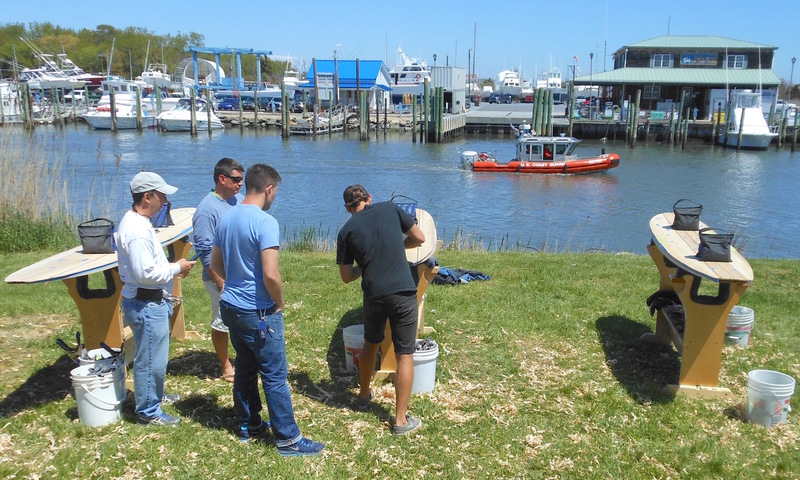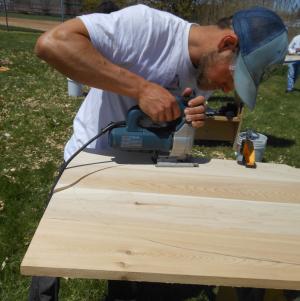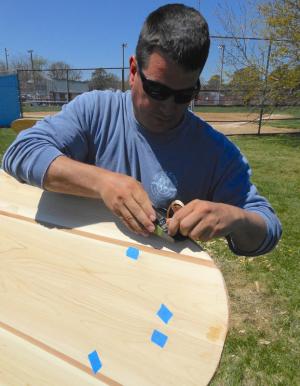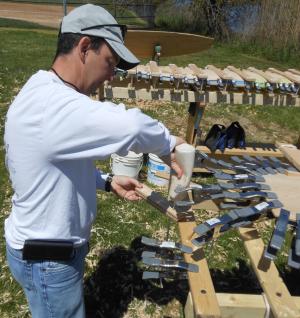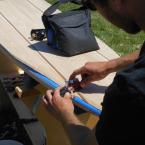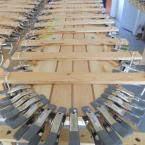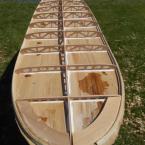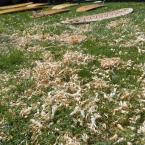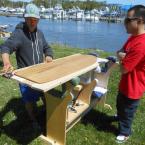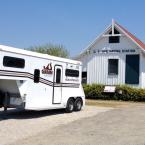Walking down the ramp facing the Lewes Rehoboth Canal behind the Lewes Life-Saving Station, John McClelland felt pretty good about his new found woodworking skills.
“I feel like building a house now,” said the Arlington, Va. resident, smiling. “But, they did build 99 percent of it.”
“They” are Grain Surfboard instructors Nolan Collins and Matt Entwistle. “It” is a surfboard made of northern white cedar planks with western red cedar strips as accents.
The two instructors from a surf shop in York, Maine, set up shop on the back lawn of the life-saving station in Lewes for four days, April 30 to May 3, to teach a group how to build a wooden surfboard. This surfboard building class on wheels has been making its way up the East Coast for the past few months.
Collins, who’s been with the company for five of its 10 years in existence, said they started in Florida with a couple of classes, made their way to the Outer Banks, had a stop in Annapolis, and would be moving on to New Jersey and New York after Lewes.
Collins said a finished 8-foot board weighs close to 20 pounds, and the materials used for construction are minimal. The boards ride great, said Collins. “You can definitely tell these are something special,” he said
Collins said the No. 1 priority on any day off is to get out surfing. He said he loves the feel of the boards in the water, and they always catch the eye of other riders.
“You don’t always want to stop and talk. You just want to get out there, but sometimes you have to because it’s such a sweet board,” he said.
Grain chose Lewes as a stop because of its connection with Dogfish Head.
Mark Carter, a surfer who oversees the brewer's Beer & Benevolence program, has been to the Maine shop and been a supporter of the business for years.
“We had to get them down here,” he said while working a handboard to use this summer.
As part of the partnership, a pre-made surfboard was auctioned off by Grain Surfboards owner Mike Lavecchia and Dogfish Head President Sam Calagione at the Dogfish Inn in Lewes. The custom board raised over $3,000 for the Delaware Chapter of the Nature Conservancy.
Collins has done the mobile classroom tour before, but only on the West Coast. This is the first time the company has offered classes on the East Coast. When this trip is done in a couple of weeks, Collins will head out west for another tour.
Instructor Matt Entwistle said this is his first tour, period. He’s been with the company for three months. He’ll be in Maine this summer.
Entwistle said he grew up in New England, but then lived in California and Alaska for a while. He said he’d been in contact with the owner for a number of years and it finally worked out to join the crew.
“This is a good community,” he said. “It’s proved to be just what I was looking for.”
The combination of wood shavings, wood glue and woodworking with great weather and the occasional boat passing by on the canal had students exuding the good-times vibe.
Michael Logue of Lewes said he had never done any woodworking before this class and that he had never heard of Grain before his wife found it on the Dogfish website.
“This has been awesome. I hope to ride this all summer,” he said.
Student Paul Uyeda of Leesburg, Va., made the nearly 4-hour trip to Lewes on Friday for a one-day class on Saturday on how to build a paipo board – a wooden bodyboard.
“I saw these guys were coming to town, and I had the time off. I knew I had to make the move and jump on it,” he said.
He said he’s been following Grain’s website for a while. He said he loves to surf and was interested to see how these guys make their boards.
“I like that they’re into sustainable woods and other environmentally friendly things,” he said. ‘It’s a way of life.”
Mike Withrow of Magnolia said he’s been following the guys for years and had always wanted to make one of their boards.
“Soon as I saw the workshop, I signed up,” he said. “I’ve been surfing since I was 12, but there’s nothing like riding something you built.”
Construction of a Grain Surfboard
The all-wood Grain Surfboards are made mostly of northern white cedar from Maine. Some of the boards use western red cedar from California as accents.
The planks are milled to a quarter-inch-thick and then glued together edge-to-edge to create the board's width. The length of the glued-together planks is cut to size, depending on the board being built, and each board has a top and bottom layer.
The planks are molded around frames made of quarter-inch thick strips of marine-grade plywood that act as a skeleton for the otherwise hollow board. The frames have CNC machine-cut holes, to reduce the weight of the board while still providing needed stability.
The frames are held in place by the 3M marine adhesive 5200. Collins said they use this product because it remains flexible after it’s cured. An environmentally friendly epoxy resin called Entropy is used to fill naturally occurring holes in the wood. The wood glue Titebond is used in other areas, like the board's tail fin.
When the board is fully shaped and sanded, Collins said a thin layer of fiberglass is added.
Chris Flood has been working for the Cape Gazette since early 2014. He currently covers Rehoboth Beach and Henlopen Acres, but has also covered Dewey Beach and the state government. He covers environmental stories, business stories and random stories on subjects he finds interesting, and he also writes a column called Choppin’ Wood that runs every other week. He’s a graduate of the University of Maine and the Landing School of Boat Building & Design.











